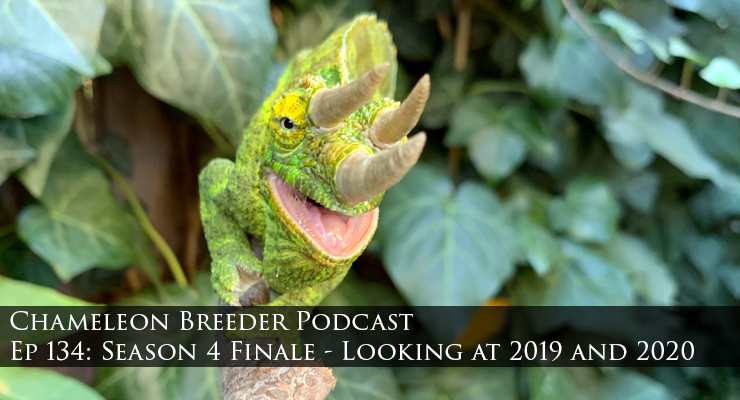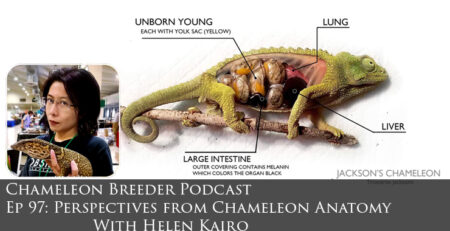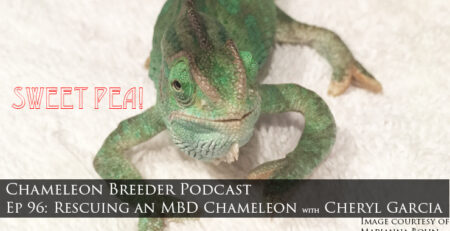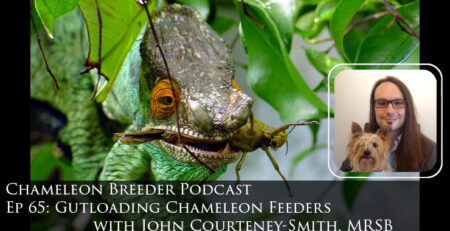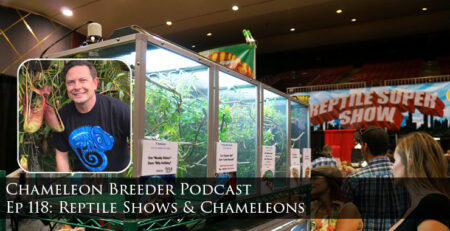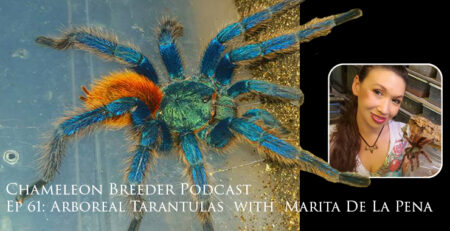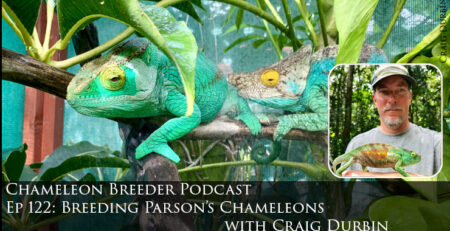134: Season 4 Finale – 2019 & 2020
Looking at 2019 & Forward to 2020
Welcome to the season 4 finale! We will be taking a winter break and preparing for season five! Sign up to the social media outreach to get regular updates over the winter break!
Transcript (more or less)
2019 has been a year of growth for us in the chameleon community in a number of ways. Today I review what progress we have made in 2019 and lay out what is ahead for us to figure out in 2020!
Welcome to another week on the Chameleon Breeder Podcast! As my long time listeners know, I take a break at the end of the year to refresh and plan for 2020. In reality, there isn’t much resting as I spend much of the time build up the episodes for the next season. So, this will be the last episode of season 4 of this podcast. I have actually started arranging interviews and recording for season 5 so you can enjoy the holidays with the confidence that the podcast will return in a few months ready to dive into moving us forward in chameleon knowledge.
2019 has been a very active year here on the podcast. Do you remember us starting this season going along with Mark Scherz on his scientific expedition to Montagne d’Ambre in Madagascar. It was a big year for Mark as he soon after received his PhD. For the first time, captive bred Meller’s Chameleons have been easily available through the efforts of Dale Tamura, Martine Dejardins, and James Killey . Frank Payne and Kevin Stanford have begun offering captive bred Furcifer minor. And Cameroon has allowed us to work with Trioceros cristatus again. Luckily, the few shipments that have come in have fallen into the hands of some dedicated breeders. Wild caught specimens from Cameroon typically come in very rough so if you have the chance to pick up a captive bred specimen of Trioceros cristatus or the peacock chameleon, Trioceros serratus, I would jump at the opportunity. Craig Durbin and Aaron Allred came on and shared their successes with the Parson’s Chameleon. The significance here is that availability of captive bred parson’s chameleons is on longer a sporadic lucky clutch that hatches. It is now a consistent success. Yes, there may be a wait if you want one, but it is no longer a huge question as to whether one will eventually be making its way to you.
I think the area we have had the greatest progress in 2019 is not only in understanding the natural hydration cycle, but implementing it. It was in season 3 that I started focusing great effort on understanding the natural cycle of cool temperatures and high humidity at night and warmer daytime temperatures with a decrease in humidity. And the results of implementing this cycle have answered some of the major struggles I have had with hydration. Why do chameleons gulp water during the day but run away from our misters? Nothing was a satisfying answer until I started working on an in-depth, multi-episode study on the Veiled Chameleon which led me across the world to find the few chameleon people that were able to travel to Yemen. In interviewing Petr Necas who has observed Chamaeleo calyptratus calyptratus in Yemen, Florida, and was responsible for sending the first specimens to the US, a picture of natural hydration cycles emerged. Further discussions with Petr about the conditions of the Jackson’s Chameleon in Kenya fleshed out that understanding. You can follow those episodes in season three and see the progression of introducing a new concept to the community.
Since then we have revisited the concept of natural hydration cycles and nighttime fogging over and over, and, more importantly, more people in the community have reproduced the success of chameleons no longer having that thirst during the day that just wasn’t making sense for an animal that goes through one or two dry seasons (depending on the region). Now, it has been a progression and a learning experience. We have had people take the concept of 100% night time humidity very seriously and pumped fog into a glass terrarium all night with very little ventilation. This definitely created 100% humidity, but crossed the line into too much of a good thing. So I did an episode Mario Jungmann on how to implement nighttime fogging with ventilation and airflow. And we will be touching on it through season five as well. These are important concepts and, like implementing UVB, I would love the problem of the community understanding it so deeply that it becomes boring to hear about it. I’ll consider that mission accomplished! Though, if I, who pretty much makes it my job to bring all this together, am still learning all the different aspects of the theory and implementation, I suspect we have a long way to go before we hit the limit!
Which, of course, provides a perfect segue into UVB which is another topic which we have discussed heavily here. This is the area that we will have great growth in 2020 in understanding. Currently, the standard advice is that you need T5 High Output linear UVB bulbs for chameleons. And this is grossly simplistic in a way that becomes dangerous. There is a huge difference between the UVB produced by a T5 5.0 in a quad bulb fixture and a T5 12% in a single bulb fixture. And then people are now playing around with 14% T5 for their chameleon. Just because we have not measured where the limit is for safe UVB does not mean it doesn’t exist. Too little UVB is a serious problem. But that doesn’t mean that the sky is the limit for blasting the cage with UVB. Saying T5 is not enough. And then there are situations where the lower power of t8s or even compact fluorescents are more appropriate. These are all tools. When used appropriately they are the perfect solution. When misused they can cause MBD or burns. So, we will be diving into meticulous detail on implementing UVB lights. This is sorely needed in our present T5 focused community. T5s are a great tool. But they need to be understood.
Of course, the purpose of getting the UVB is to get the supplementation correct. It would be great to be able to get synthetic vitamin D3 out of the diet. People have done it. I have done it. But I am trying different things with different groups of babies to truly understand where the limits are. We need to know a little bit more before we cut the community off the synthetic D3 powders cold turkey.
So let’s talk about where we need to go in the coming year. Here are the unknowns that are on my plate.
- What is the lowest effective UVB level we can provide in our chameleon cage and get full necessary vitamin D3 synthesis? Both Pete Hawkins and I have verified that UVI 3 does the job for veiled chameleons. So, does UVI 2 work? How about UVI 1? Is it different for panther chameleons or jackson’s chameleons? We will be working on getting at least the beginnings of those answers in 2020.
- What are necessary parameters for growing up Jackson’s Chameleons? This species is known to be extra sensitive and difficult to grow up past four months. Why do some people experience a sudden die off? This is unknown. Hypothesises include not enough nighttime temperature drop, a fat soluble vitamin deficiency where they got an initial dose from their mother, but ran out of by three months, or simply the stresses of co-habitation. This is difficult as the effects of all of these are cumulative and would happen over time. Therefore it is exceedingly tough to isolate one. But that is what we are here for. How necessary is the night time drop? How deep does it have to go? Figuring out the vitamin A transfer from mother to babies is also in there. Though I have to say, if you were to ask me which I think the most likely of those three our sudden death reports are due to, I would put my vote on the close cohabitation of babies. The differences in singly raised babies and group raised babies are not hard to reproduce. Of course, the answer could be all of them!
- How do we get preformed vitamin A out of our supplementation? We have yet to figure out the pattern between the successful breeders who never use pre-formed vitamin A and the keeper of one chameleon that gets vitamin A deficiency. This is complicated by the oversimplification of the community that says that chameleons do not convert carotenoids. This is based on one experiment where beta carotene did not appear to convert to vitamin A in panther chameleons. Long term breeding projects that do not use preformed vitamin A at all show that there is much more to the story and this one study should not be used as a broadbrush. But until the few people pushing our knowledge forward can pin point a reproduceable solution I fear we cannot change the narrative. The mob prefers over-confidence to truthful acknowledgement of the limits of our knowledge. No matter the subject, if you say “we don’t know” you will be immediately replaced by the Facebook expert that has no problem taking advantage of the unknowns to know they can’t be proven wrong with whatever it is they have decided is universal truth. Just be careful out there. A confident answer is not always confidence from true understanding.
And, you are welcome to join in finding any of these answers. If any one of these challenges speaks to you then contact me and we can discuss how to coordinate efforts. We are not producing a scientific paper. We are crowdsourcing. This is how it works. One person makes a hypothesis or makes a discovery within somewhat controlled conditions. Then someone else takes it a step further and adds something. At all times, everything must be defined enough that anyone else can repeat the experiment. There is not “trust me” involved here. It is 100% “challenge and check” me. In the case of UV Index, There are two numbers we care about. The minimum effective UV Index for D3 synthesis and the maximum safe UV Index to where damage is not caused within the approved cage set-up. Minimum effective UV Index is tested as whether a female of the species can lay a fully calcified clutch of eggs. If she can do that and recover to standard daily activity we can be functionally certain that her body has been able to synthesize as much D3 as she needed. Pete Hawkins raised up a female veiled chameleon under a UV Index of 3 and never gave D3 in her supplements. This female has laid successive clutches of fully calcified eggs. Perfect. Strong data point. I grabbed that and did a test with two pairs. One under UVI 3 and one under UVI 6. I confirmed his results of UVI 3. And with the second pair under UVI 6 I showed that more UVB does not produce healthier or bigger animals. This was to squash one of those Facebook sayings that was not founded on anything proven and, even with a PhD in biology saying it was false -it just wouldn’t die. It takes a lot of work to prove something. It takes no work to spout off something which has circumstantial evidence at best. So, no, higher UVB does not make for larger chameleons. If anyone wants to say that that is true again they will have to have at least the same level of controlled, reproduceable experiment. That is the way science works even at our loose hobby level. But the point here is that I was able to build off of what Pete did and use UVI 3 as a proven starting point with known success. So to go forward, I will be raising babies under UVI 2 and UVI 1 to see if those levels are sufficient. UVI 3 works, but it may be more than they need. In fact, I would be surprised if that much is needed. But there is only one way to find out. Hopefully, sometime in Season five we will be talking about the results of this test. One guy’s test with limited numbers is hardly a definitive test, but it is far better than determining chameleon husbandry based on who has more time to post the most times on Facebook. And, remember, anything I present as a conclusion is encouraged to be challenged. Check and challenge everything. But, and here is the rule, if you are going to challenge it, you have to have at least the same level of experimentation. I know social media has empowered everyone to think that every opinion has equal weight and can be, nay, should beshared…but I suggest we reign back that enthusiasm and be thoughtful of the value of quality check-and-challenge.
One thing I would like to say about the husbandry information that has been passed down to us is that I have a healthy respect for those that have gone before. Although everything needs to constantly challenged with new information and new technology we need to be careful not to become arrogant with our view of the world. There is a reason for every one of the husbandry mantras that we have. I disagree with sayings like glass cages cause respiratory infections, Jackson’s Chameleons can live together, or having substrate causes impaction. But each one of these has a kernel of truth. And before we can dismantle these myths we need to understand why they came to be. Someone somewhere observed something and enough people thought it was a good enough idea that they repeated it. So, to truly dismantle these myths so they cannot be brought back we need to dig into their origins.
There was a time when people tried keeping chameleons in glass aquariums. It did not go well and chameleons died. Screen cages were then used successfully for decades. So, before we start introducing glass terrariums back into our husbandry mix it would be appropriate to explain why the glass cage = RI saying started in the first place and explaining what is different now that we think will produce better results. And, of course, there is a podcast episode on just that.
Can we ever get away from Jackson’s Chameleons being sold as a bonded pair? Probably not, but why does this persist even with well meaning people who are not just trying to make extra money? The kernel of truth here is that Jackson’s Chameleons are just more subtle in their body communication that can be observed by humans. We already are coming to the table with the assumption that everything in the animal kingdom wants to pair up like we humans do. So, through the filter or our life experience, it appears that they are getting along.
Experienced keepers know this isn’t true, but we have to be aware and respect that that is what it looks like to the casual observer. And usually the casual observer is who we are talking to. Be aware that even when you explain everything, it still looks like they are getting along. So there is a lot of explaining that must accompany you saying that Jackson’s Chameleons should be kept separate. Once again, I dedicated an entire podcast to explaining it. And that is the huge advantage to having a podcast. I am given 30 minutes to explain a simple concept which, we all know, is not really simple.
As far as substrate and impaction. Someone somewhere had a chameleon with substrate in their stomach and got constipated and died. Necropsy shows substrate in the digestive track. Conclusion: substrate = impaction = death. This is a nice clean conclusion if you ignore all the people keeping chameleons in naturalistic terrariums with open soil all around and not having impaction issues. So, what do we do with this one? Well, we follow the same template. Figure out its origins, figure out how it is understood today, and then address both of those in your argument to put the myth to rest. Not all of these are straight forward and not all the origins are known, but for anyone trying to move the community forward, it is important to understand where things came from and deal with that origin. It is like finding the rootball of the weed. That is the only way to make sure it doesn’t just keep coming back.
One thing that will be very different in 2020 is that I will be gearing the Dragon Strand chameleon caging line to give greater support to the naturalistic hydration cycles. Listeners to my caging episode will remember that a cage can, simply, be considered a container that has differing levels of ventilation. The community is slowly transitioning from the 100% screen cage which, actually, is a difficult cage to work with when considering humidity. This is why so many people close off one to three sides of the screen cage. It is kind of funny that the people giving advice that chameleons need screen cages are okay with cutting off ventilation as long as there is a screen cage underneath! But I will admit there is a benefit to dynamically adjusting how much ventilation you have. That said, I think training the community in the use of fans to create airflow is the right way to go rather than to do screen cage hacks. We did one episode this season on airflow. There will be more. And, the advantage of being in charge of my own chameleon caging company is that my cage designs can adjust to what we in the chameleon community need. It drives my manufacturer crazy to have to constantly be making changes, but the whole reason for me doing this is that we can have a caging company that adjusts to the latest in chameleon husbandry advances rather than us having to adjust to whatever the manufacturer of cheap import cages decides is most cost effective.
2020 will be an exciting year of growth. And we are going to embrace the growth. Note that the reason this podcast exists is not to just blare out standard husbandry advice in a different medium. It is to be a constant notification of what we are figuring out. It is the centerpiece of gathering the advances within the hobbyist community. The scientific community writes papers which are then able to be added to everyone’s library of information. The hobbyist community, unfortunately, has a much more tribal knowledge base. My hope is that by selecting the most experienced breeder and keepers to bring on here that you can assimilate their experience and spend your time breaking new ground. One of the most significant hobbyist findings in 2020 may be the establishment of the minimum effective UV Index for vitamin D3 synthesis in veiled chameleons. Even if we find out it has to be a minimum of UVI 3, there is tremendous value in knowing that is the limit. And so, through this podcast, you’ll be able to follow the progress. We are checking and challenging everything we think we know and are actively creating tomorrow’s husbandry guidelines.
Thank you for spending this time with me every week. Stay safe, and keep an eye on the social media accounts for the announcement of season five. I am most active on Instagram under my Chameleon_Breeder account. You can also find me on the Chameleon Breeder Facebook account, but, if you want to discuss a chameleon husbandry situation, the best place to go is The Chameleon Enthusiasts Facebook group where I am part of a whole team that can help. You’ll find a number of previous podcast guests there. Previous guests Dr. Chris Anderson, Dr. Mark Scherz, Elise Stein, and Alycia Lowe are there so you have a concentration of competence in one place. I’ll put these links in the show notes. And I’d like to remind you all that the best way to keep track of what is going on here is with the Chameleon Breeder iPhone app. Here you will have all the episodes in easy reach. It has been a wonderful and extremely productive season four. I wish you safe holidays and remind you to be very careful how you wrap up those special feeders for under the Christmas tree. You don’t need your gift to Godzilla unwrapping itself! And, with that, it is time to exit stage left. I shall see you next year!

